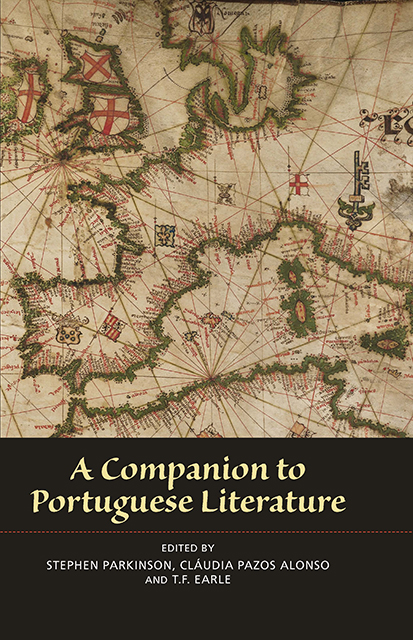Book contents
- Frontmatter
- Contents
- Acknowledgements
- Notes on the Contributors
- Introduction
- 1 Eight Centuries of Portuguese Literature: An Overview
- 2 The Medieval Galician-Portuguese Lyric
- 3 Fernão Lopes and Portuguese Prose Writing of the Middle Ages
- 4 Portuguese Theatre in the Sixteenth Century: Gil Vicente and António Ferreira
- 5 The Lusiads and the Literature of Portuguese Overseas Expansion
- 6 Lyric Poetry in the Sixteenth Century
- 7 The Seventeenth Century
- 8 The Eighteenth Century
- 9 Almeida Garrett: Founder of Modern Portuguese Literature
- 10 The Transition from Romanticism to Realism: Alexandre Herculano, Camilo Castelo Branco and Júlio Dinis
- 11 Eça de Queirós: A European Writer
- 12 Fernando Pessoa and the Modernist Generation
- 13 Narrative and Drama during the Dictatorship
- 14 Women Writers up to 1974
- 15 Writing after the Dictatorship
- 16 Portuguese Literature in English Translation
- Index
2 - The Medieval Galician-Portuguese Lyric
Published online by Cambridge University Press: 03 March 2023
- Frontmatter
- Contents
- Acknowledgements
- Notes on the Contributors
- Introduction
- 1 Eight Centuries of Portuguese Literature: An Overview
- 2 The Medieval Galician-Portuguese Lyric
- 3 Fernão Lopes and Portuguese Prose Writing of the Middle Ages
- 4 Portuguese Theatre in the Sixteenth Century: Gil Vicente and António Ferreira
- 5 The Lusiads and the Literature of Portuguese Overseas Expansion
- 6 Lyric Poetry in the Sixteenth Century
- 7 The Seventeenth Century
- 8 The Eighteenth Century
- 9 Almeida Garrett: Founder of Modern Portuguese Literature
- 10 The Transition from Romanticism to Realism: Alexandre Herculano, Camilo Castelo Branco and Júlio Dinis
- 11 Eça de Queirós: A European Writer
- 12 Fernando Pessoa and the Modernist Generation
- 13 Narrative and Drama during the Dictatorship
- 14 Women Writers up to 1974
- 15 Writing after the Dictatorship
- 16 Portuguese Literature in English Translation
- Index
Summary
The secular genres (Rip Cohen)
The medieval Galician-Portuguese lyric (not counting the Cantigas de Santa Maria) is a corpus of around 1,680 texts, composed by some one hundred and sixty poets, and traditionally divided into three genres, cantigas de amigo (female-voiced lyric), cantigas de amor (male-voiced lyric) and cantigas de escarnho e de mal dizer (poetry of mockery and insult), hereinafter Amigo, Amor, and CEM. This division, which could have been induced from the poetry itself, is based on evidence from the manuscript tradition, from the fragmentary and untitled Arte de Trovar (as it is often called by modern scholars), and from references in the texts themselves. There is no good reason to challenge it, even if there are some hybrid cases, and a substantial number of texts which are grouped with the CEM while having nothing to do with insult or mockery.
The three main genres can be distinguished for present purposes using the concept of ‘matrix’. The matrix of a genre is a complex of form, pragmatics, and rhetoric. By ‘form’ I mean strophic form, verse length, rhyme-schemes, and virtuosic techniques such as coblas unissonans (‘unison verses’, using the same rhyme-sounds in each strophe) coblas doblas (‘double verses’, alternating two sets of rhyme-sounds), or dobre (using the same word twice in the same position in each strophe). Pragmatics includes the identity, social condition, and relationship of speaker and addressee, the background situation, the speech-action (i.e. the action(s) being performed by speech within the text), and emotion(s). By rhetoric is meant lexicon, phraseology, the interrelation of syntax and strophic form, and the many techniques, including figures of speech and thought, which are used to communicate a message (in Roman Jakobson's sense) and perform a social act.
The cantigas de amigo are female-voiced love lyric, and this is what marks them off not only from the other two genres, but from nearly all of medieval Romance love lyric. In them we find, in relation to the other two genres, simpler strophic forms, such as aaB and aaBB, simpler rhyme-systems, and far fewer virtuosic techniques, though individual cantigas de amigo may be more complex than individual poems in the other two genres.
- Type
- Chapter
- Information
- A Companion to Portuguese Literature , pp. 25 - 44Publisher: Boydell & BrewerPrint publication year: 2009
- 2
- Cited by



